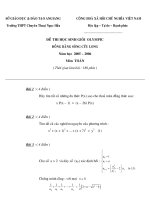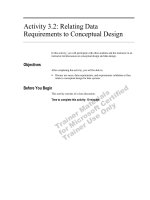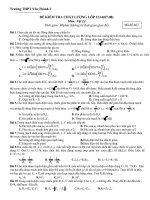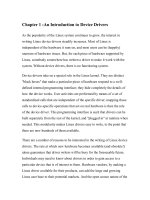Tài liệu Linux Device Drivers-Chapter 1 :An Introduction to Device Drivers ppt
Bạn đang xem bản rút gọn của tài liệu. Xem và tải ngay bản đầy đủ của tài liệu tại đây (287.08 KB, 24 trang )
Chapter 1 :An Introduction to Device Drivers
As the popularity of the Linux system continues to grow, the interest in
writing Linux device drivers steadily increases. Most of Linux is
independent of the hardware it runs on, and most users can be (happily)
unaware of hardware issues. But, for each piece of hardware supported by
Linux, somebody somewhere has written a driver to make it work with the
system. Without device drivers, there is no functioning system.
Device drivers take on a special role in the Linux kernel. They are distinct
"black boxes" that make a particular piece of hardware respond to a well-
defined internal programming interface; they hide completely the details of
how the device works. User activities are performed by means of a set of
standardized calls that are independent of the specific driver; mapping those
calls to device-specific operations that act on real hardware is then the role
of the device driver. This programming interface is such that drivers can be
built separately from the rest of the kernel, and "plugged in" at runtime when
needed. This modularity makes Linux drivers easy to write, to the point that
there are now hundreds of them available.
There are a number of reasons to be interested in the writing of Linux device
drivers. The rate at which new hardware becomes available (and obsolete!)
alone guarantees that driver writers will be busy for the foreseeable future.
Individuals may need to know about drivers in order to gain access to a
particular device that is of interest to them. Hardware vendors, by making a
Linux driver available for their products, can add the large and growing
Linux user base to their potential markets. And the open source nature of the
Linux system means that if the driver writer wishes, the source to a driver
can be quickly disseminated to millions of users.
This book will teach you how to write your own drivers and how to hack
around in related parts of the kernel. We have taken a device-independent
approach; the programming techniques and interfaces are presented,
whenever possible, without being tied to any specific device. Each driver is
different; as a driver writer, you will need to understand your specific device
well. But most of the principles and basic techniques are the same for all
drivers. This book cannot teach you about your device, but it will give you a
handle on the background you need to make your device work.
As you learn to write drivers, you will find out a lot about the Linux kernel
in general; this may help you understand how your machine works and why
things aren't always as fast as you expect or don't do quite what you want.
We'll introduce new ideas gradually, starting off with very simple drivers
and building upon them; every new concept will be accompanied by sample
code that doesn't need special hardware to be tested.
This chapter doesn't actually get into writing code. However, we introduce
some background concepts about the Linux kernel that you'll be glad you
know later, when we do launch into programming.
The Role of the Device Driver
As a programmer, you will be able to make your own choices about your
driver, choosing an acceptable trade-off between the programming time
required and the flexibility of the result. Though it may appear strange to say
that a driver is "flexible," we like this word because it emphasizes that the
role of a device driver is providing mechanism, not policy.
The distinction between mechanism and policy is one of the best ideas
behind the Unix design. Most programming problems can indeed be split
into two parts: "what capabilities are to be provided" (the mechanism) and
"how those capabilities can be used" (the policy). If the two issues are
addressed by different parts of the program, or even by different programs
altogether, the software package is much easier to develop and to adapt to
particular needs.
For example, Unix management of the graphic display is split between the X
server, which knows the hardware and offers a unified interface to user
programs, and the window and session managers, which implement a
particular policy without knowing anything about the hardware. People can
use the same window manager on different hardware, and different users can
run different configurations on the same workstation. Even completely
different desktop environments, such as KDE and GNOME, can coexist on
the same system. Another example is the layered structure of TCP/IP
networking: the operating system offers the socket abstraction, which
implements no policy regarding the data to be transferred, while different
servers are in charge of the services (and their associated policies).
Moreover, a server like ftpd provides the file transfer mechanism, while
users can use whatever client they prefer; both command-line and graphic
clients exist, and anyone can write a new user interface to transfer files.
Where drivers are concerned, the same separation of mechanism and policy
applies. The floppy driver is policy free -- its role is only to show the
diskette as a continuous array of data blocks. Higher levels of the system
provide policies, such as who may access the floppy drive, whether the drive
is accessed directly or via a filesystem, and whether users may mount
filesystems on the drive. Since different environments usually need to use
hardware in different ways, it's important to be as policy free as possible.
When writing drivers, a programmer should pay particular attention to this
fundamental concept: write kernel code to access the hardware, but don't
force particular policies on the user, since different users have different
needs. The driver should deal with making the hardware available, leaving
all the issues about how to use the hardware to the applications. A driver,
then, is flexible if it offers access to the hardware capabilities without adding
constraints. Sometimes, however, some policy decisions must be made. For
example, a digital I/O driver may only offer byte-wide access to the
hardware in order to avoid the extra code needed to handle individual bits.
You can also look at your driver from a different perspective: it is a software
layer that lies between the applications and the actual device. This privileged
role of the driver allows the driver programmer to choose exactly how the
device should appear: different drivers can offer different capabilities, even
for the same device. The actual driver design should be a balance between
many different considerations. For instance, a single device may be used
concurrently by different programs, and the driver programmer has complete
freedom to determine how to handle concurrency. You could implement
memory mapping on the device independently of its hardware capabilities,
or you could provide a user library to help application programmers
implement new policies on top of the available primitives, and so forth. One
major consideration is the trade-off between the desire to present the user
with as many options as possible and the time in which you have to do the
writing as well as the need to keep things simple so that errors don't creep in.
Policy-free drivers have a number of typical characteristics. These include
support for both synchronous and asynchronous operation, the ability to be
opened multiple times, the ability to exploit the full capabilities of the
hardware, and the lack of software layers to "simplify things" or provide
policy-related operations. Drivers of this sort not only work better for their
end users, but also turn out to be easier to write and maintain as well. Being
policy free is actually a common target for software designers.
Many device drivers, indeed, are released together with user programs to
help with configuration and access to the target device. Those programs can
range from simple utilities to complete graphical applications. Examples
include the tunelpprogram, which adjusts how the parallel port printer driver
operates, and the graphical cardctl utility that is part of the PCMCIA driver
package. Often a client library is provided as well, which provides
capabilities that do not need to be implemented as part of the driver itself.
The scope of this book is the kernel, so we'll try not to deal with policy
issues, or with application programs or support libraries. Sometimes we'll
talk about different policies and how to support them, but we won't go into
much detail about programs using the device or the policies they enforce.
You should understand, however, that user programs are an integral part of a
software package and that even policy-free packages are distributed with
configuration files that apply a default behavior to the underlying
mechanisms.
Splitting the Kernel
In a Unix system, several concurrent processesattend to different tasks. Each
process asks for system resources, be it computing power, memory, network
connectivity, or some other resource. The kernel is the big chunk of
executable code in charge of handling all such requests. Though the
distinction between the different kernel tasks isn't always clearly marked, the
kernel's role can be split, as shown in Figure 1-1, into the following parts:
Figure 1-1. A split view of the kernel
Process management
The kernel is in charge of creating and destroying processes and
handling their connection to the outside world (input and output).
Communication among different processes (through signals, pipes, or
interprocess communication primitives) is basic to the overall system
functionality and is also handled by the kernel. In addition, the
scheduler, which controls how processes share the CPU, is part of
process management. More generally, the kernel's process
management activity implements the abstraction of several processes
on top of a single CPU or a few of them.
Memory management
The computer's memory is a major resource, and the policy used to
deal with it is a critical one for system performance. The kernel builds
up a virtual addressing space for any and all processes on top of the
limited available resources. The different parts of the kernel interact
with the memory-management subsystem through a set of function
calls, ranging from the simple malloc/free pair to much more exotic
functionalities.
Filesystems
Unix is heavily based on the filesystem concept; almost everything in
Unix can be treated as a file. The kernel builds a structured filesystem
on top of unstructured hardware, and the resulting file abstraction is
heavily used throughout the whole system. In addition, Linux supports
multiple filesystem types, that is, different ways of organizing data on
the physical medium. For example, diskettes may be formatted with
either the Linux-standard ext2 filesystem or with the commonly used
FAT filesystem.
Device control
Almost every system operation eventually maps to a physical device.
With the exception of the processor, memory, and a very few other
entities, any and all device control operations are performed by code
that is specific to the device being addressed. That code is called a
device driver. The kernel must have embedded in it a device driver for
every peripheral present on a system, from the hard drive to the
keyboard and the tape streamer. This aspect of the kernel's functions is
our primary interest in this book.
Networking
Networking must be managed by the operating system because most
network operations are not specific to a process: incoming packets are
asynchronous events. The packets must be collected, identified, and
dispatched before a process takes care of them. The system is in
charge of delivering data packets across program and network
interfaces, and it must control the execution of programs according to
their network activity. Additionally, all the routing and address
resolution issues are implemented within the kernel.
Toward the end of this book, in Chapter 16, "Physical Layout of the Kernel
Source", you'll find a road map to the Linux kernel, but these few paragraphs
should suffice for now.
One of the good features of Linux is the ability to extend at runtime the set
of features offered by the kernel. This means that you can add functionality
to the kernel while the system is up and running.
Each piece of code that can be added to the kernel at runtime is called a
module. The Linux kernel offers support for quite a few different types (or
classes) of modules, including, but not limited to, device drivers. Each
module is made up of object code (not linked into a complete executable)
that can be dynamically linked to the running kernel by the insmod program
and can be unlinked by the rmmod program.
Figure 1-1 identifies different classes of modules in charge of specific tasks -
- a module is said to belong to a specific class according to the functionality
it offers. The placement of modules in Figure 1-1 covers the most important
classes, but is far from complete because more and more functionality in
Linux is being modularized.
Classes of Devices and Modules
The Unix way of looking at devices distinguishes between three device
types. Each module usually implements one of these types, and thus is
classifiable as a char module, a block module, or a network module. This
division of modules into different types, or classes, is not a rigid one; the
programmer can choose to build huge modules implementing different
drivers in a single chunk of code. Good programmers, nonetheless, usually
create a different module for each new functionality they implement,
because decomposition is a key element of scalability and extendability.
The three classes are the following:









